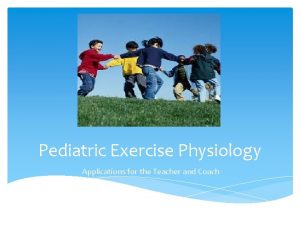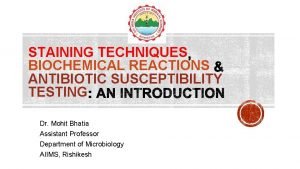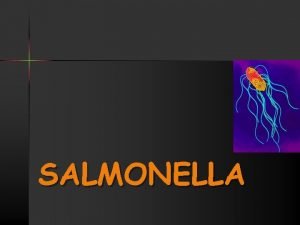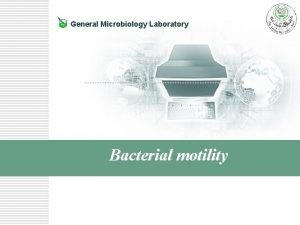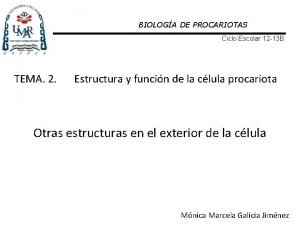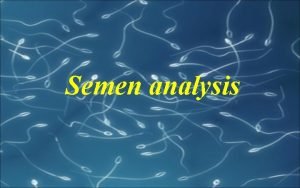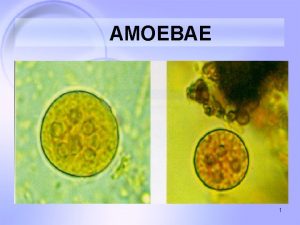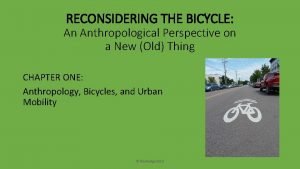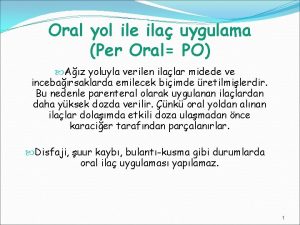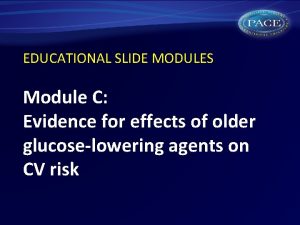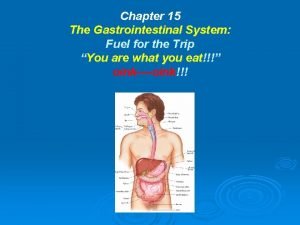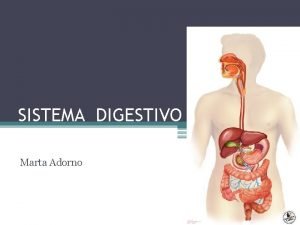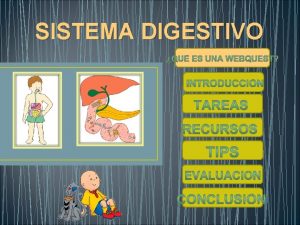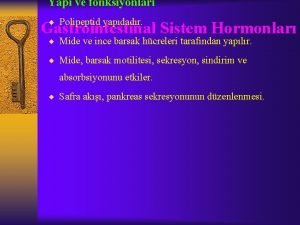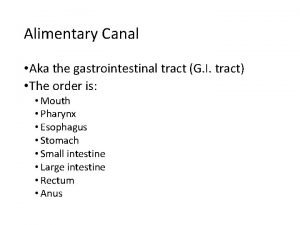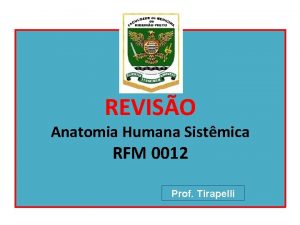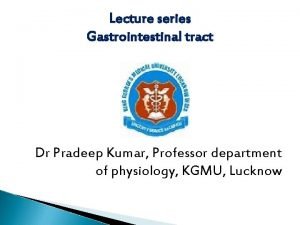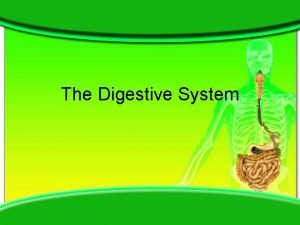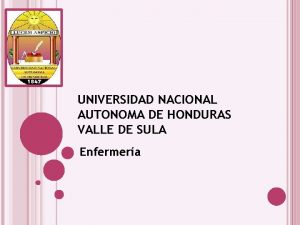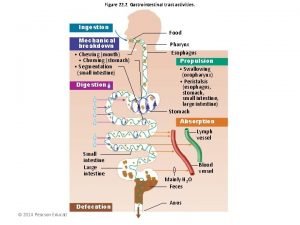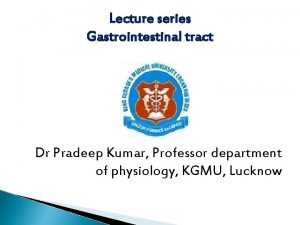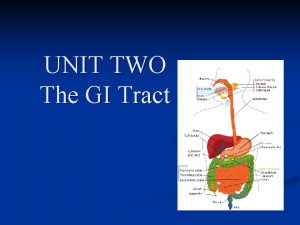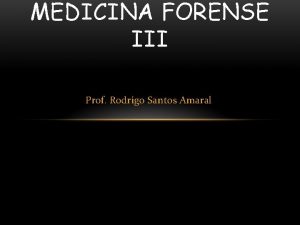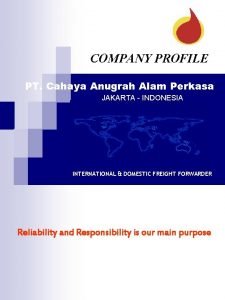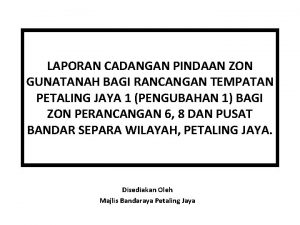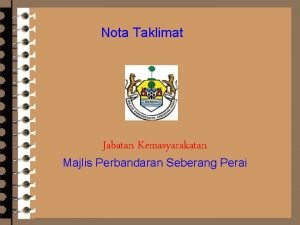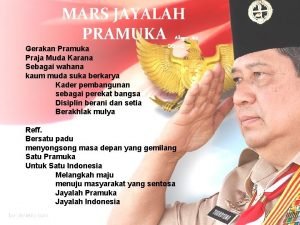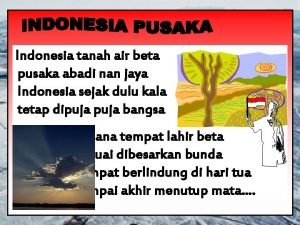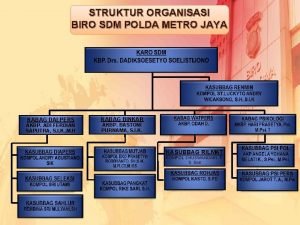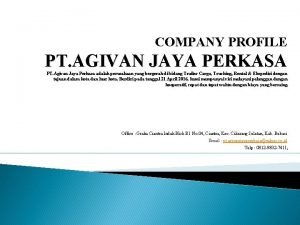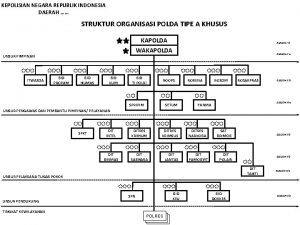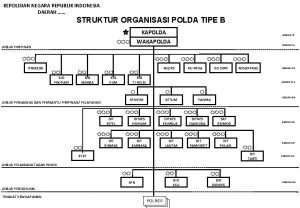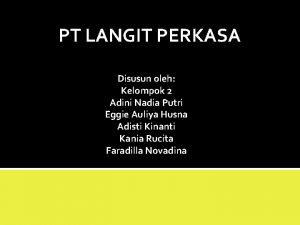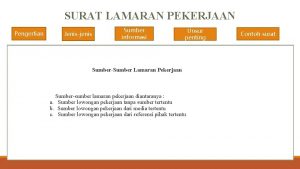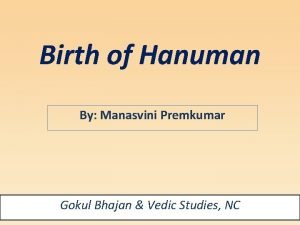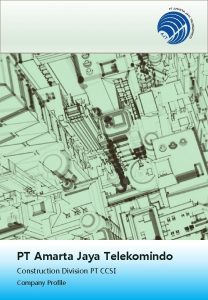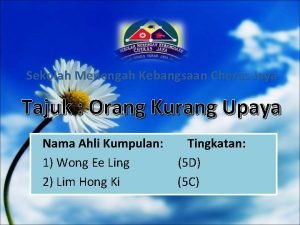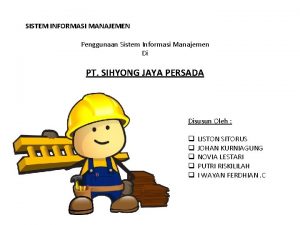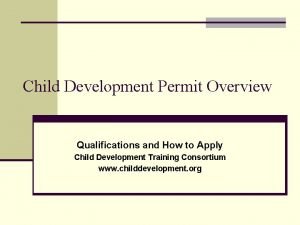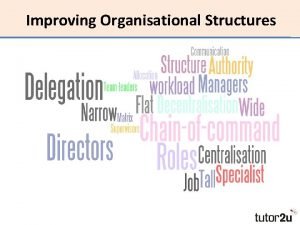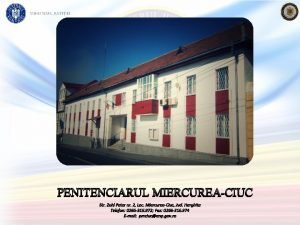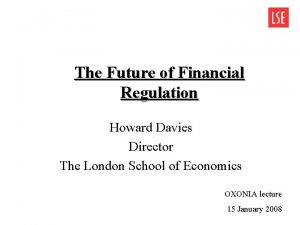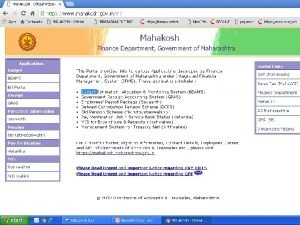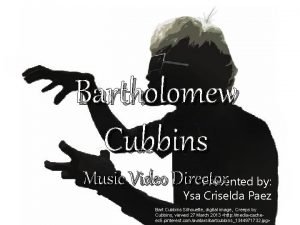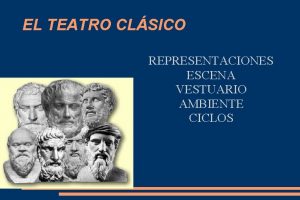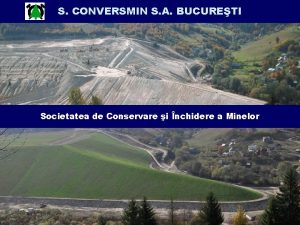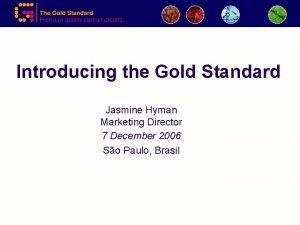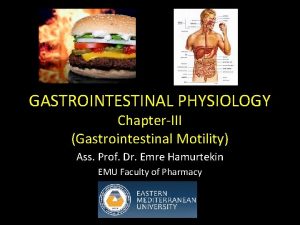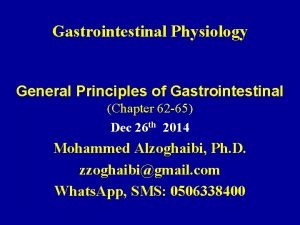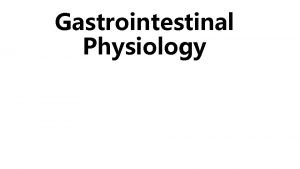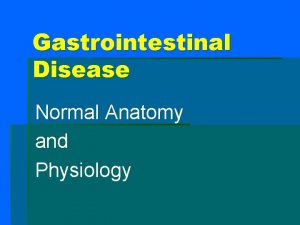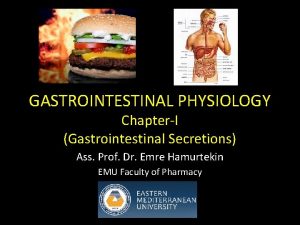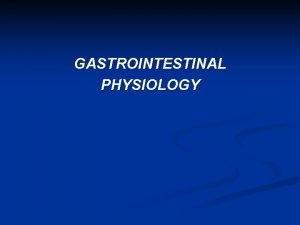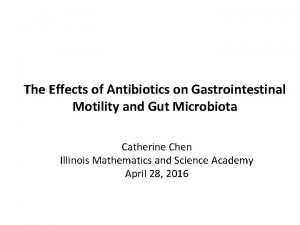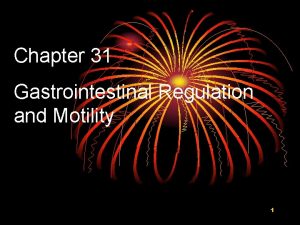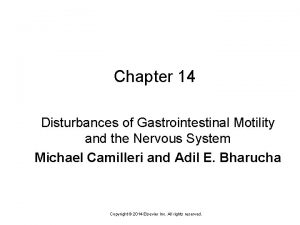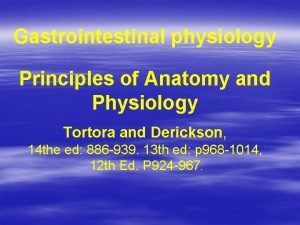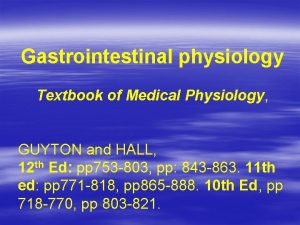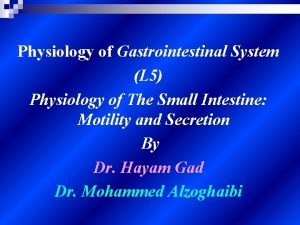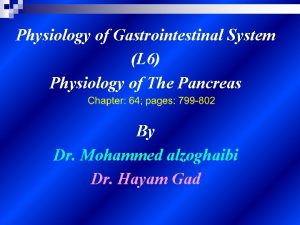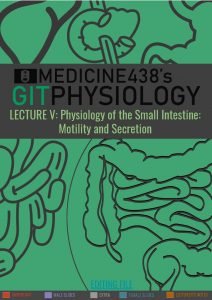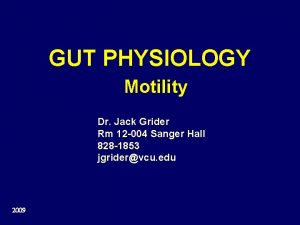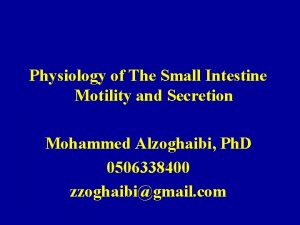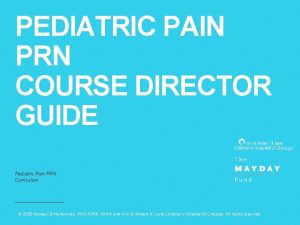GASTROINTESTINAL MOTILITY PHYSIOLOGY JAYA PUNATI MD DIRECTOR PEDIATRIC













































































- Slides: 77

GASTROINTESTINAL MOTILITY PHYSIOLOGY JAYA PUNATI, MD DIRECTOR, PEDIATRIC GASTROINTESTINAL, NEUROMUSCULAR AND MOTILITY DISORDERS PROGRAM DIVISION OF PEDIATRIC GASTROENTEROLOGY AND NUTRITION, CHILDREN’S HOSPITAL LOS ANGELES VRINDA BHARDWAJ, MD DIVISION OF PEDIATRIC GASTROENTEROLOGY AND NUTRITION CHILDREN’S HOSPITAL LOS ANGELES EDITED BY: CHRISTINE WAASDORP HURTADO, MD REVIEWED BY: JOSEPH CROFFIE, MD, MPH

NASPGHAN PHYSIOLOGY EDUCATION SERIES EDITORS: CHRISTINE WAASDORP HURTADO, MD, MSCS, FAAP CHRISTINE. WAASDORP@CHILDRENSCOLORADO. ORG DANIEL KAMIN, MD DANIEL. KAMIN@CHILDRENS. HARVARD. EDU

CASE STUDY 1 • 14 year old female • With no significant past medical history • Presents with persistent vomiting and 20 lbs weight loss x 3 months • Initially emesis was intermittent, occurred before bedtime or soon there after, 2 -3 hrs after a meal • Now occurring immediately or up to 30 minutes after a meal • Emesis consists of undigested food and is nonbloody and nonbilious • Associated with heartburn and chest discomfort 3

CASE STUDY 1 • Initial screening blood work was unremarkable • A trial of acid blockade was started with improvement in heartburn only • Antiemetic therapy with ondansetron showed no improvement • Upper endoscopy on acid blockade was normal 4

CASE STUDY 1 Differential for functional/motility disorders: • Esophageal disorders: – Achalasia – Gastroesophageal Reflux – Other esophageal dysmotility disorders • Gastric disorders: – Gastroparesis – Rumination syndrome – Gastric outlet obstruction : pyloric stricture, pyloric stenosis • Small bowel: – Small bowel Neuropathy or Myopathy 5

CASE STUDY 2 • 12 year old male • Presents with a history of chronic constipation • Mother does not remember when he first passed meconium but does report frequent use of glycerin suppositories in infancy • Toilet training attempted at 3 years of age; Witholding behavior (potty dance; hiding behind the furniture) • Fecal incontinence began around 4 -5 years of age • Currently no stooling in the toilet • Fecal incontinence several times a day with no sensation 6

CASE STUDY 2 Differential for functional/motility disorders: – Functional Constipation – Hirschsprung's Disease – Irritable Bowel Syndrome – Internal Sphincter Damage or Weakness – Nerve Damage (e. g. : Meningomyelocele repair) – Pelvic Floor Dyssynergia 7

SECTION I 8

OBJECTIVES Understand the components of Gastrointestinal Motility Esophageal Gastric Small Intestinal Colonic Anorectal 9

WHAT IS GASTROINTESTINAL MOTILITY ? • Gastrointestinal (GI) motility is defined as the coordinated contractions and relaxations of the muscles of the GI tract necessary to move contents from the mouth to the anus • Peristalsis is the result of a series of local reflexes • Contraction of intestinal muscle above an intraluminal stimulus associated with simultaneous relaxation of muscle below the stimulus 10

STARLING’S LAW OF THE INTESTINE 11 Image from: Biology of Gastrointestinal tract textbook. Chapter 1 Gastrointestinal Hormones and Neurotransmitters Rodger A. Liddle

MECHANISMS OF PERISTALSIS 12

PATTERNS OF MOTILITY 13 Images from http: //www. zuniv. net/physiology/book/images/22 -3. jpg

PATTERNS OF MOTILITY 14

ESOPHAGEAL MOTILITY Esophageal peristalsis results from sequential contraction of circular muscle, which serves to push the ingested food bolus toward the stomach 15 Image from: http: //www. webmd. com/digestive-disorders/picture-of-the-esophagus

ESOPHAGEAL MOTILITY Upper Esophageal Sphincter (UES) - Briefly opens during swallowing and initiates primary peristalsis Esophageal Body (Hollow Tube) - Primary Peristalsis : Swallow induced peristalsis, primary function is to keep the esophagus empty - Secondary Peristalsis : is induced by esophageal distention and not by swallow. It is important for clearance of retained material and refluxate from the stomach - Tertiary Peristalsis : Non-propulsive, irregular contractions, at times synchronous, exact physiological function unknown Lower Esophageal Sphincter (LES) - 2 to 4 cm in length, tonically contracted 15 - 40 mm Hg - Relaxes 1 -2 seconds after swallow, remains open for 6 -8 seconds 16

Primary Esophageal Peristalsis Aorta Conventional manometry tracing Image from GI Motility online (May 2006) | High resolution manometry topography Image from Neurogastroenterol Motil. 2012 Mar 24; Suppl 1: 57 -65.

ESOPHAGEAL PRESSURE TOPOGRAPHY SCORING OF INDIVIDUAL SWALLOWS 18 Chicago classification criteria of esophageal motility disorders defined in high resolution esophageal pressure topography. Bredenoord AJ, Smout AJ; International High Resolution Manometry Working Group. Neurogastroenterol Motil. 2012 Mar; 24 Suppl 1: 57 -65.

ACHALASIA SUBTYPES • Type I - achalasia with minimum esophageal pressurization • Type II - achalasia with esophageal compression or pan-esophageal pressurization • Type III - achalasia with distal esophageal body spasm. 19 Image from : Gastroenterology. 2008 Nov; 135(5): 1526 -33.

Motility Patterns in other Esophageal Smooth Muscle Disorders Image from Dr Shaker - GI Motility online (May 2006)

CHICAGO CLASSIFICATION OF ESOPHAGEAL MOTILITY DISORDERS 21 Image from: Gastroenterology. 2008 Nov; 135(5): 1526 -33.

INTERSTITIAL CELLS OF CAJAL Interstitial cells of Cajal (ICC) are the pacemaker cells in the gut Generate and propagate slow waves in gastrointestinal muscles The frequency of slow waves determines the frequency of contractions of the stomach, intestine and colon Slow waves also determine the direction and velocity of propagation of peristaltic activity, in concert with the enteric nervous system 22

GASTRIC MOTILITY 23 Image from J Thompson, Ph. D

GASTRIC MOTILITY 24

SMALL INTESTINAL MOTILITY • Slow waves initiated by Interstitial Cells of Cajal • Always present, but requires spike potentials to initiate contractions • Frequency is 3/min stomach, 12/min duodenum, 7/min ileum, 9/min cecum, and 16/min sigmoid colon • Whether spike potentials and, hence, contractions occur depends on neural, hormonal and local influences 25

INTESTINAL REFLEXES • Peristaltic reflex or “law of the intestines”, i. e. , upstream contraction and downstream receptive relaxation when a bolus distends the intestine • Intestinointestinal reflex is an inhibition of contractile activity when the intestine is severely distended • Gastroileal reflex is a relaxation of the ileocecal sphincter after a meal that moves chyme into the colon. This reflex is mediated by vagus nerve and gastrin • Gastrocolic reflex is stimulation of high or low amplitude colonic contractility with gastric distention or nutritive stimulus 26

MIGRATING MOTOR COMPLEXES 27

MIGRATING MOTOR COMPLEX (MMC) Phase II-Mixing Phase III – Propulsive Phase I – Quiet High resolution topography of MMC High resolution topography of antrum pyloric contractions Antrum & Pylorus Patient images from Jaya Punati, MD - CHLA

HUMAN COLONIC CONTRACTILE PATTERNS • Segmental Activity • Single Contractions • Groups (Bursts) of Contractions • Rhythmic • Arrhythmic • Propagated Activity • Low Amplitude Propagated Contractions • High Amplitude Propagated Contractions 29

COLONIC PROPULSIVE ACTIVITY HAPC High amplitude 100 mm Hg propagative contractions LAPC segmental Low amplitude Propagative contractions Patient images from Jaya Punati, MD - CHLA

HIGH AMPLITUDE PROPAGATIVE CONTRACTIONS Mass movements and haustral changes associated with colonic contractions as noted by barium enema. 31

CONTROL OF PROXIMAL DESCENDING AND SIGMOID COLON • Distension of the ileum causes the ileocecal sphincter to relax (ileocecal reflex) • Distension of the colon causes the ileocecal sphincter to contract • 1 to 3 times per day a peristaltic mass movement propels material through the colon • Gastroileal and gastrocolic reflexes with relaxation of ileocecal valve produces a mass movement in the proximal colon shortly after a meal due to the action of gastrin and extrinsic autonomic nerves 32

GASTROCOLIC REFLEX Meal started Meal ended Gastrocolic response 30 minutes Patient images from Jaya Punati, MD - CHLA

ANORECTAL MOTILITY - DEFECATION Image from http: //msk-anatomy. com/

RECTOANAL INHIBITORY REFLEX - RAIR Rectal balloon distention RAIR 4 cc RAIR Anal canal length External sphincter High Resolution topography Modified from source: Sierra scientific

SECTION II 36

OBJECTIVE Understand the Neuronal and Hormonal Peptides that modulate Gastrointestinal Motility 37

Regulation of GI Motility 38

INTERSTITIAL CELLS OF CAJAL (ICC) - PACEMAKERS 39

EXCITATION CONTRACTION COUPLING STIMULATING PERISTALSIS 40

NEURAL CONTROL OF GASTRODUODENAL MOTILITY Phase Stimulus Mechanism Effect on Motility Gastric Increase Gastric motility and emptying Long neural reflexes (gastroileal reflex) Increased activity in the ileum Gastrin Intestinal Increased segmenting movements in ileum; relaxes ileocecal sphincter Distention of the small intestine Long and short neural reflexes Increased strength of segmentation Reduced intestinal volume: fasting Long and short neural reflexes; initiated by increased blood levels of motilin Initiates MMC (peristalsis); repeats until next meals 41

NEURAL CONTROL OF DEFECATION 42 Image from: http: //www. zuniv. net/physiology/book/images/22 -5

HORMONAL REGULATION OF GUT MOTILITY 43 Image from: Gut hormones and the regulation of energy homeostasis; Kevin G. Murphy and Stephen R. Bloom; Nature 444, 854 -859(14 December 2006)

HORMONAL REGULATION OF GUT MOTILITY 44 Image from: Biology of Gastrointestinal tract textbook. Chapter 1 Gastrointestinal Hormones and Neurotransmitters Rodger A. Liddle

HORMONAL REGULATION OF GUT MOTILITY Hormone Site of Production Stimulus For Production Target Organ Activity Cholecystokinin (CCK) Duodenal mucosa Fatty Chyme Stomach Liver/pancreas Pancreas Gallbladder Hepatopancreatic sphincter Inhibits stomach’s secretory activity Potentiates secretin’s actions Increase pancreatic secretion Stimulate contraction and expulsion of bile Relaxes sphincter allowing secretions into duodenum Gastric inhibitory peptide (GIP) Duodenal mucosa Fatty Chyme Stomach Pancreas (beta cells) Inhibits HCl production Stimulates insulin release Gastrin Stomach mucosa – G cells Partially digested food; acetylcholine released from nerve cells Stomach (parietal cells) Small intestine Ileocecal valve Large intestine Increases HCl secretion Stimulates gastric emptying Stimulates small intestine contractions Relaxes ileocecal valve Stimulates movement Histamine Stomach mucosa Food in stomach Stomach Activates parietal cells to release HCl Intestinal gastrin Duodenal mucosa Acidic and partially digested food in duodenum Stomach Stimulates gastric glands and motility 45

HORMONAL REGULATION OF GUT MOTILITY Hormone Site of Production Stimulus For Production Target Organ Activity Motilin Duodenal mucosa Fasting; periodic release by neural stimuli (1. 5 -2 hrs) Proximal duodenum Stimulates MMC Secretin Duodenal mucosa Acidic chyme Stomach Inhibits gastric gland secretion Inhibits gastric motility during gastric secretion Increases pancreatic juice secretion: potentiates CCK Increases bile output Pancreas Liver Serotonin Stomach mucosa Food in stomach Stomach Causes contraction of the stomach Somatostatin Stomach mucosa and duodenal mucosa Food in stomach; sympathetic nerve stimulation Stomach Pancreas Small intestine Inhibits gastric secretion Inhibits GI blood flow and intestinal absorption Inhibits contraction and bile release Gallbladder and liver Vasoactive intestinal peptide (VIP) Enteric neurons Partially digested food Small intestine Pancreas Stomach Stimulates buffer secretion Dilates intestinal vasculature Relaxes intestinal smooth muscle Increases secretion 46 Inhibits acid secretion

FACTORS AFFECTING GASTRIC EMPTYING Duodenal chemoreceptors Acid Gastrointestinal hormones Secretin Delayed gastric emptying Cholecystokinin Fat Amino acid peptides Gastric inhibitory peptide (GIP) Gastrin 47

REGULATION OF GI MOTILITY EXCI INHIBI TATORY Ach Adenosine Bombesin CCK GRP Histamine Motilin • • • TORY Neurokinin A Opioids PGE 2 Serotonin SP TRH • • CGRP GABA Galanin Glucagon NPY Neurotensin NO PACAP PHI PYY Serotonin Secretin Somatostatin VIP 48

Regulation of GI Motility 49 http: //www. zuniv. net/physiology/book/chapter 22. html

SECTION III 50

OBJECTIVE Understand the Ontogeny of Gastrointestinal Motility 51

EMBRYOLOGIC ASPECTS OF MOTILITY DEVELOPMENT 52 Image from http: //www. med. umich. edu/

MATURATION OF MOTOR FUNCTIONS The average resting UES pressure (mean ± SD) in preterm neonates at 33 weeks postmenstrual age (PMA) is 17 ± 7 mm Hg In full-term neonates, it is 26 ± 14 mm Hg and in adults, it is 53 ± 23 mm Hg With growth and maturation, the muscle mass, tone and activity of the UES improve Similarly, changes in LES length and tone have been observed with growth 53

MATURATION OF MOTOR FUNCTIONS • The specific characteristics of UES and primary esophageal peristalsis exist by 33 weeks PMA • At 36 weeks PMA, completely propagated secondary peristalsis, greater with liquids than with air, is developed • Although fetal peristalsis is recognized and the muscles and neural structures are present by 32 weeks gestation, local neural transmission and integration of peristalsis mature throughout fetal life and continue to develop during the first postnatal year 54

Maturation of motor functions • The gastric compliance is low in the first hours of life and is normal by 3 days (Zangen T et al, 2001) • Gastric emptying is not altered by feeding temperature or non-nutritive sucking • Calorically denser formula and infant massage (vagal mediation) hastens gastric emptying. • Bolus feedings delay gastric emptying due to rapid distention 55

MATURATION OF MOTOR FUNCTIONS • The absence of the MMC in the very preterm infant <32 weeks gestation – appears to result from immaturity of motor patterns, – absence of the motilin receptor, and – absence of fluctuating levels of motilin • There is a lack of data on colonic motility in preterm human infants 56

SECTION IV 57

OBJECTIVE Understand the Nonpeptide Neurotransmitters that control Gastrointestinal Motility 58

AUTONOMIC NERVOUS SYSTEM REGULATION OF MOTILITY Image from: http: //www. zuniv. net/physiology/book/images/fp 6 -1 59

ACETYLCHOLINE AND NOREPINEPHRINE Visceral effectors Cranial Parasympathetic neurons Brain Preganglionic fiber ACh Ganglion ACh Sympathetic neurons ACh Postganglionic fiber NE Paravertebral Ganglion ACh NE Collateral Ganglion Sacral parasympathetic neurons ACh ACh = acetylcholine (cholinergic) NE = norepinephrine (adrenergic)

DOPAMINE Dopamine is the predominant catecholamine neurotransmitter Dopamine is synthesized from Tyrosine by tyrosine hydroxylase Dopamine actions: § Central: regulates food intake and vomiting reflex, § Peripherally: controls hormone secretion, vascular tone, and gastrointestinal motility Dopamine acts via two distinct receptor subtypes: types 1 and 2 § The presynaptic Dopamine receptors have an excitatory response, occurring at a low agonist concentration § The postsynaptic receptors mediate inhibitory effects 61

SEROTONIN 62

EFFECT OF 5 HT RECEPTORS ON GI MOTILITY 63 Biology of Gastrointestinal tract textbook. Chapter 1 Gastrointestinal Hormones and Neurotransmitters Rodger A. Liddle

NITRIC OXIDE 64 Biology of Gastrointestinal tract textbook. Chapter 1 Gastrointestinal Hormones and Neurotransmitters Rodger A. Liddle

NITRIC OXIDE Impaired NO synthesis of the myenteric plexus seems to be an important contributing factor to the pathogenesis of • Achalasia • Diabetic gastroparesis • Infantile hypertrophic pyloric stenosis • Hirschsprung's disease • Chagas' disease 65

SECTION V 66

OBJECTIVE Understand the Role of Extrinsic Nervous System and the Enteric Nervous System in modulating Gastrointestinal Motility 67

ENTERIC NERVOUS SYSTEM

BRAIN GUT AXIS BRAIN and SPINAL CORD STIMUL I SENSORY RECEPTORS Mechanical Chemical ENTERIC NERVOUS SYSTEM EFFECTORS Motility Secretion Blood flow

SENSORY INNERVATION AND VISCERAL PAIN 70

VISCERAL HYPERALGESIA Endogenous Modulation Cortex Brain stem Spinal Hyperexcitability Nitric oxide activation Long-term Hyperalgesia End organ sensitivity “Silent” nociceptors Visceral Hypersensitivity Allodynia Hyperalgesia Tonic Cortical regulation Neuroplasticity

BIOPSYCHOSOCIAL MODEL OF DISEASE IN IBS Early life • • Psychosocial factors Genetics Environment CNS Physiology • • • Life stress Psychological state Coping Social support ENS Motility Sensation IBS • Symptom experience • Behavior Outcome • • Medications MD visits Daily function Quality of life

BRAIN/GUT INTERACTION IN POST-INFECTIOUS IBS Psychological distress Mucosal inflammation Visceral Sensitivity Acute infection trigger IBS Symptoms Dysmotility Increased Secretion Image from: Drossman, Gut 1999; 44: 306 Gwee et al. Gut 1999: 44: 400

SUMMARY Gastrointestinal smooth muscle cells contract as a unit because of anatomic and electrical coupling Smooth muscles contractions may last for a few seconds (phasic), or minutes to hours (tonic) Material moves through the gastrointestinal (Gl) tract from regions of higher to lower intraluminal pressure Interstitial cells of Cajal are the pacemaker cells of the gut leading to regularly occurring depolarizations (3 -5/ min) called slow waves 74

SUMMARY Primary peristaltic contractions are initiated in the esophagus by swallowing and are responsible for moving most material through the esophagus; secondary peristaltic contractions initiated by distension and local reflexes remove any “leftover” material The principal motility function of the orad (proximal) stomach is receptive relaxation, the caudal (distal) stomach is mixing, trituration and emptying Small intestinal motility is characterized by brief, irregular contractions interrupted during fasting approximately every 60 -90 min by a wave of intense contractions, migrating motor complexes, (MMCs) that sweeps the entire length of the small intestine. 75

SUMMARY • The ileocecal sphincter relaxes when the ileum is distended and contracts when the colon distends, thus allowing material to enter the colon and preventing reflux • The principal movements of the proximal colon are weak peristaltic contractions that permit storage of contents and absorption of most remaining water • Two or three times a day, a peristaltic mass movements, High Amplitude propagating contractions, propel a significant amount of material into the distal colon or rectum. Distension of the rectum triggers the rectosphincteric reflex 76

REFERENCES Johnson, L. R. , ed. Gastrointestinal Physiology, 6 th ed. St. Louis: C. V. Mosby, 2001. Schemann, M. , Journal of Pediatric Gastroenterology & Nutrition, Sept 2005 - Vol 41: pp S 4 -S 6 Singendonk MM, Omari TI et al. Neurogastroenterol Motil. 2014 Jul 23 Mayer AE, Gebhart GF. Basic and clinical aspects of visceral hyperalgesia. Gastroenterol. 1994; 107: 271 -93. Drossman, Gut 1999; 44: 306 Gwee et al. Gut 1999: 44: 400 Jadcheria, S. , Berseth, C. , Development of Gastrointestinal Motility Reflexes. Camborov, P. , Hubka, P. , The pacemaker activity of Interstitial Cells of Cajal and gastric electrical activity, Physiol. Res. 52: 275 -284, 2003. Toku Takanashi, Journal of Gastroenterology May 2003, Volume 38, issue 5, pp 421430 Zangen T et al, 2001 Biology of Gastrointestinal tract textbook. Chapter 1 Gastrointestinal Hormones and Neurotransmitters Rodger A. Liddle 77
 Jaya jaya radha krishna yugala milana lyrics
Jaya jaya radha krishna yugala milana lyrics Pediatric exercise physiology
Pediatric exercise physiology Stately motility
Stately motility Motility
Motility Triple sugar iron
Triple sugar iron Motility definition
Motility definition Gliding motility
Gliding motility Sperm volume normal range
Sperm volume normal range Entamoeba histolytica motility
Entamoeba histolytica motility Hanging drop method for motility
Hanging drop method for motility Motility vs mobility
Motility vs mobility Emt chapter 18 gastrointestinal and urologic emergencies
Emt chapter 18 gastrointestinal and urologic emergencies Vajinaya ilaç uygulama
Vajinaya ilaç uygulama Metformin and constipation
Metformin and constipation Gastrointestinal embryology
Gastrointestinal embryology Chapter 15 the gastrointestinal system
Chapter 15 the gastrointestinal system Partes do sistema digestorio
Partes do sistema digestorio Embriologia del sistema gastrointestinal
Embriologia del sistema gastrointestinal Sefalik faz
Sefalik faz Alimentary canal in order
Alimentary canal in order Gastrointestinal tract
Gastrointestinal tract Gastrointestinal hormones
Gastrointestinal hormones Sistema digestorio
Sistema digestorio Gastrointestinal structure
Gastrointestinal structure Gastrointestinal tract
Gastrointestinal tract Gastrointestinal medical terminology breakdown
Gastrointestinal medical terminology breakdown Pneumatic reduction of intussusception
Pneumatic reduction of intussusception Motilidad gastrointestinal
Motilidad gastrointestinal Sigid djuniawan
Sigid djuniawan What is gastrointestinal disease
What is gastrointestinal disease Gastrointestinal
Gastrointestinal Gastrointestinal tract
Gastrointestinal tract Focused physical assessment
Focused physical assessment Nursing diagnosis for pud
Nursing diagnosis for pud Dumping syndrome signs
Dumping syndrome signs Marca electrica de jellinek
Marca electrica de jellinek Pt anugrah alam jaya perkasa
Pt anugrah alam jaya perkasa Mammoth empire holding sdn bhd
Mammoth empire holding sdn bhd Majlis perbandaran seberang jaya
Majlis perbandaran seberang jaya Pramuka praja muda karana
Pramuka praja muda karana Indonesia tanah air beta pusaka abadi nan jaya indonesia
Indonesia tanah air beta pusaka abadi nan jaya indonesia Struktur organisasi resmob
Struktur organisasi resmob Bumd sarana jaya
Bumd sarana jaya Pt allindo jaya perkasa
Pt allindo jaya perkasa Struktur polda sumut 2020
Struktur polda sumut 2020 Allindo
Allindo Struktur organisasi rorena
Struktur organisasi rorena Pt langit jaya perkasa
Pt langit jaya perkasa Maksud kariah masjid
Maksud kariah masjid Jaya srila prabhupada
Jaya srila prabhupada Sumber surat lamaran
Sumber surat lamaran Rama raghava jaya seetha nayaka lyrics
Rama raghava jaya seetha nayaka lyrics Dr rama vaidyanathan
Dr rama vaidyanathan Amarta jaya telekomindo
Amarta jaya telekomindo Smk cj
Smk cj Pt sihyong jaya persada
Pt sihyong jaya persada Apa itu udeg udeg raja
Apa itu udeg udeg raja Perusahaan dagang kondang jaya
Perusahaan dagang kondang jaya Shree krishna chaitanya prabhu nityananda
Shree krishna chaitanya prabhu nityananda Child development matrix
Child development matrix Development acrostic poem
Development acrostic poem Macromedia director mx
Macromedia director mx Director or manager
Director or manager Director
Director Miercurea ciuc penitenciar
Miercurea ciuc penitenciar Howard davies (director)
Howard davies (director) National security agency careers
National security agency careers Analyst hierarchy
Analyst hierarchy Directorate of treasuries
Directorate of treasuries English comic actor and film director
English comic actor and film director Who is he
Who is he Fashion show staff positions
Fashion show staff positions Vestuario de teatro griego
Vestuario de teatro griego Single window director
Single window director Conversmin
Conversmin Oliver stone
Oliver stone Jasmine hyman
Jasmine hyman Director communication style
Director communication style

